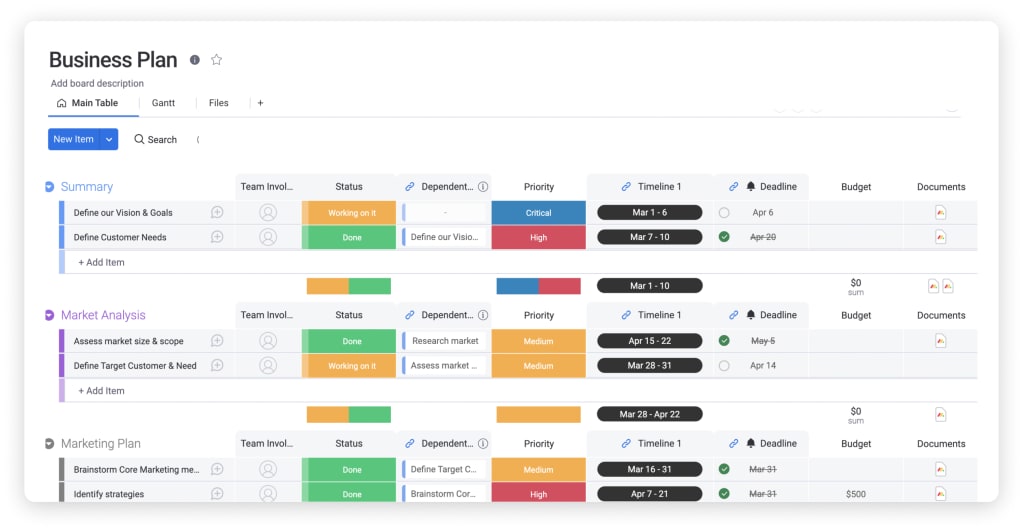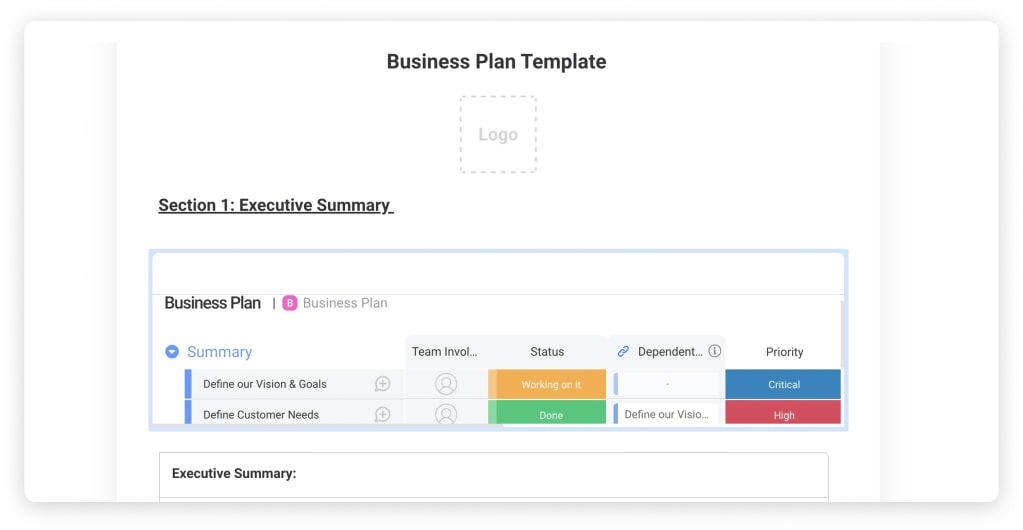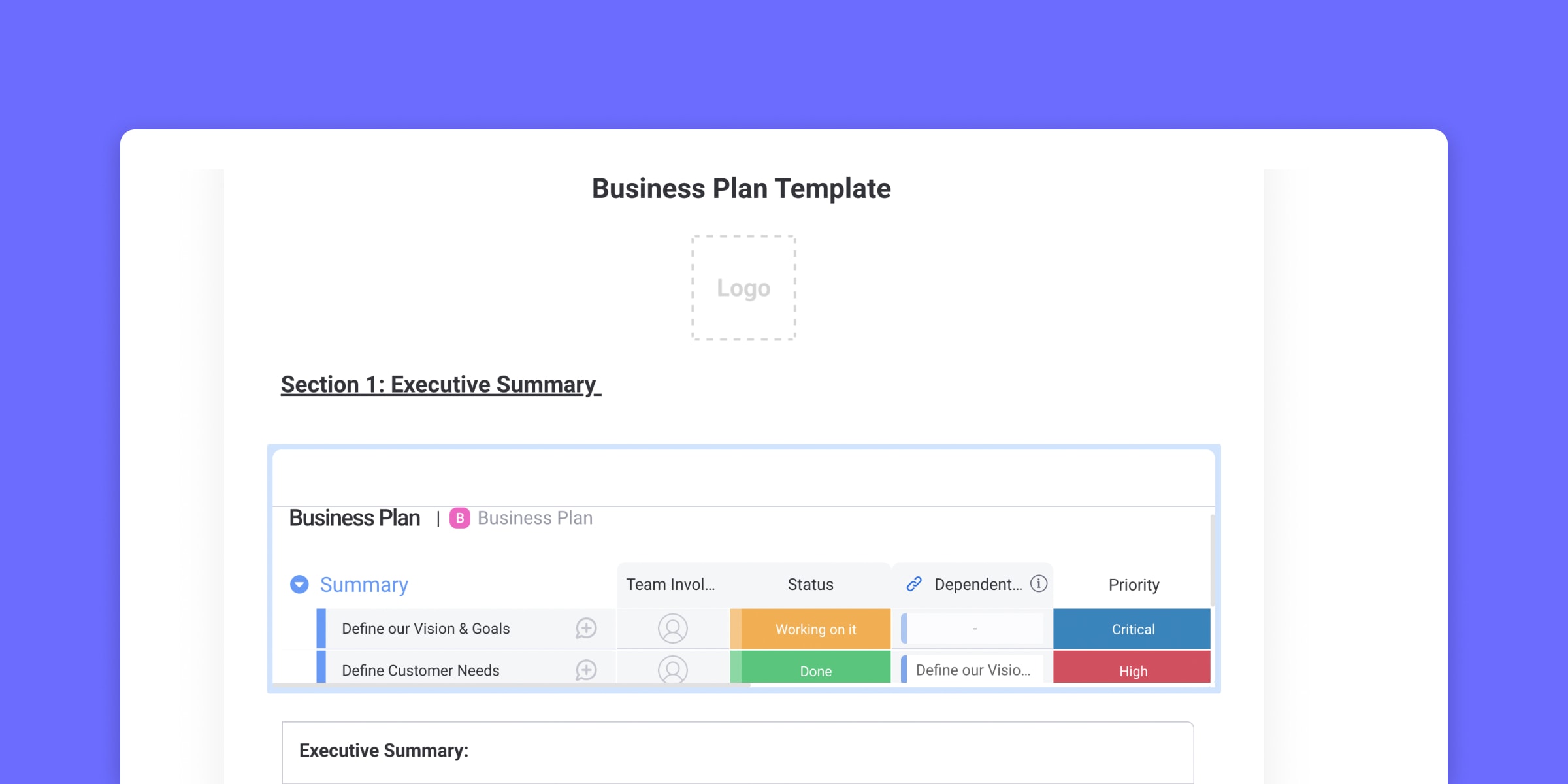If you’re looking to start a new charity but don’t know where to start, a nonprofit business plan template can help. There are more than 1.5 million nonprofit organizations registered in the US. While it’s awesome that there are so many charitable orgs, unfortunately, many of them struggle to keep their doors open.
Like any other business, a nonprofit needs to prepare for the unexpected. Even without a global pandemic, strategic planning is crucial for a nonprofit to succeed.
In this article, we’ll look at why a business plan is important for nonprofit organizations and what details to include in your business plan. To get you started, our versatile nonprofit business plan template is ready for you to download to turn your nonprofit dreams into a reality.
What is a nonprofit business plan template?
A nonprofit business plan template is not that different from a regular, profit-oriented business plan template. It can even focus on financial gain — as long as it specifies how to use that excess for the greater good.
A nonprofit business plan template includes fields that cover the foundational elements of a business plan, including:
- The overarching purpose of your nonprofit
- Its long and short-term goals
- An outline of how you’ll achieve these goals
The template also controls the general layout of the business plan, like recommended headings, sub-headings, and questions. But what’s the point? Let’s dive into the benefits a business plan template offers nonprofits.
Why use a nonprofit business plan template?
To get your nonprofit business plans in motion, templates can:
Provide direction
If you’ve decided to start a nonprofit, you’re likely driven by passion and purpose. Although nonprofits are generally mission-driven, they’re still businesses. And that means you need to have a working business model. A template will give your ideas direction and encourage you to put your strategic thinking cap on.
Help you secure funding
One of the biggest reasons for writing a nonprofit business plan is to attract investment. After all, without enough funding, it’s nearly impossible to get your business off the ground. There’s simply no business without capital investment, and that’s even more true for nonprofits that rarely sell products.
Stakeholders and potential investors will need to assess the feasibility of your nonprofit business. You can encourage them to invest by presenting them with a well-written, well-thought-out business plan with all the necessary details — and a template lays the right foundation.
Facilitate clear messaging
One of the essential characteristics of any business plan — nonprofits included — is transparency around what you want to achieve and how you are going to achieve it. A nebulous statement with grandiose aspirations but no practical plan won’t inspire confidence.
Instead, you should create a clear and concise purpose statement that sums up your goals and planned action steps. A good template will help you maintain a strong purpose statement and use clear messaging throughout.
Of course, there are different types of nonprofit plan templates you can use, depending on the kind of business plan you want to draw up.
What are some examples of a nonprofit business plan template?
From summary nonprofit plans to all encompassing strategies, check out a few sample business plan templates for different nonprofit use cases.
Summary nonprofit business plan template
New nonprofit ventures in the early stages of development can use this business plan template. It’s created to put out feelers to see if investors are interested in your idea. For example, you may want to start an animal shelter in your community, but aren’t sure if it’s a viable option due to a lack of funds. You’d use a summary business plan template to gauge interest in your nonprofit.
Full nonprofit business plan template
In this scenario, you have already laid the foundations for your nonprofit. You’re now at a point where you need financing to get your nonprofit off the ground.
To draw your investors in and give them confidence in you and your vision, you need to write a complete business plan.This template is much longer than a summary and includes all the sections of a nonprofit business plan including the:
- Executive summary
- Nonprofit description
- Needs analysis
- Product/service
- Marketing strategy
- Management team & board
- Human resource needs
- Finances
It also typically includes a variety of documents that back up your market research and financial situation.
Operational nonprofit business plan template
This type of business plan template is extremely detail-oriented and outlines your nonprofit’s daily operations. It acts as an in-depth guide for who does what, how they should do it, and when they should do it.
An operational nonprofit business plan is written for your internal team rather than external parties like investors or board members.
Convinced to give a business plan template a go? Lucky for you, our team has created the perfect option for nonprofits.
monday.com’s nonprofit business plan template
At monday.com, we understand that starting a nonprofit business can feel overwhelming — scrambling to line up investors, arranging fundraising events, filing federal forms, and more. Because we want you and your nonprofit to succeed, we’ve created a customizable template to get you started. It’s right inside our Work OS, a digital platform that helps you effectively manage every aspect of your work — from budgets and high-level plans to individual to-do lists.

Here’s what you can do on our template:
Access all your documents from one central location
Besides a business plan, starting a nonprofit requires a lot of other documentation. Supporting documents include a cash flow statement or a general financial statement, resumes of founders, and letters of support.
monday.com’s Work OS lets you store all these essential documents in one centralized location. That means you don’t need to open several tabs or run multiple programs to view your information. On monday.com, you can quickly and easily access documents and share them with potential investors and donors. Security features also help you control access to any board or document, only letting invited people or employees view or edit them. By keeping everything in one place, you save time on tracking down rogue files or statements and can focus on what really matters, such as running your nonprofit.
Turn your business plan into action
With monday.com’s nonprofit business plan template, you can seamlessly transform your plan into actionable tasks. After all, it’s going to take more than some sound strategic planning to bring your nonprofit to life.

Based on your business plan, you have the power to create interactive vision boards, calendars, timelines, cards, charts, and more. Because delegation is key, assign tasks to any of your team members from your main board. You can even set up notification automations so that everyone stays up to date with their responsibilities. Plus, to make sure the team stays on track, you can use the Progress Tracking Column that shows you the percent to completion of tasks based on the different status columns of your board.
Keep your finger on the pulse
From budgets to customer satisfaction, you need to maintain a high-level overview of your nonprofit’s key metrics.
monday.com keeps you well-informed on the status of your nonprofit’s progress, all on one platform. With customizable dashboards — for example, a real-time overview of donations received and projects completed — and visually appealing views, you can make confident decisions on how to take your nonprofit business forward.
Now that you have the template, let’s cover each section and how to fill it out correctly.
Essential sections of a nonprofit business plan template
So what exactly goes into a nonprofit business plan? Let’s take a look at the different sections you’ll find in most templates.
Executive summary
This is a concise summary of your business at the beginning of your plan. It should be both inspired and to the point. The executive summary is typically two pages long and dedicates about two sentences to each section of the plan.
Organization overview
This section gives some background on your company and summarizes the goal of your business. At the same time, it should touch on other important factors like your action plan for attracting potential external stakeholders. You can think of an organization overview as a mission statement and company description rolled into one.
Products, programs, and services
Any business exists to provide products, programs, and services — perhaps with a focus on the latter two for nonprofits. Your business plan should outline what you are bringing to your community. This will influence your target market, potential investors, and marketing strategies.
Marketing plan
An effective marketing strategy is the cornerstone of any successful business. Your marketing plan will identify your target audience and how you plan to reach them. It deals with pricing structures while also assessing customer engagement levels.
Operational plan
The operational plan describes the steps a company will take over a certain period. It focuses on the day-to-day aspects of the business, like what tasks need to be done and who is responsible for what. The operational section of a business plan works closely with strategic planning.
Competitive analysis
Even nonprofits face competition from other nonprofits with similar business profiles. A market analysis looks at the strengths and weaknesses of competing businesses and where you fit in. This section should include a strategy to overtake competitors in the market. There are many formats and templates you can use here, for example, a SWOT analysis.
Financial plan
Your financial plan should be a holistic image of your company’s financial status and financial goals. As well as your fundraising plan, make sure to include details like cash flow, investments, insurance, debt, and savings.
Before we wrap up, we’ll address some commonly asked questions about nonprofit business plan templates.
FAQs about nonprofit business plan templates
How do you write a business plan for a nonprofit?
The best way to write a nonprofit business plan is with a template so that you don’t leave anything out. Our template has all the sections ready for you to fill in, combined with features of a cutting-edge Work OS.
For some extra tips, take a look at our advice on how to write a business plan. We’ve detailed the various elements involved in business planning processes and how these should be structured.
How many pages should a nonprofit business plan be?
Business plans don’t have to be excessively long. Remember that concise communication is optimal. As a rule of thumb — and this will vary depending on the complexity and size of your business plan — a nonprofit business plan is typically between seven and thirty pages long.
What is a nonprofit business plan called?
A nonprofit business plan is called just that — a ‘nonprofit business plan.’ You may think that its nonprofit element makes it very different from a profit-oriented plan. But it is essentially the same type of document.
What is the best business structure for a nonprofit?
The consensus is that a corporation is the most appropriate and effective structure for a nonprofit business.
How do you start a nonprofit with no money?
Creating a business plan and approaching potential investors, aka donators, is the best way to start a nonprofit business if you don’t have the funds yourself.


